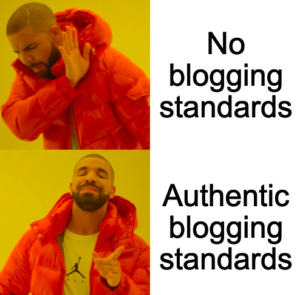If you’ve seen one blog, you’ve seen them all… unless. Once in a while, you’ll stumble across a blog that breaks the mold of the masses. It is unique, engaging, and entertaining. It is a blog that standouts, and deserves the attention. But what makes this blog a beautiful outlier?
Over 70 million blog posts are published every month on WordPress. That’s a lot of content, but a lot of the content looks and sounds the same. Few real, authentic blogs exist in the saturated digital environment.

However, many individuals and businesses invest significant resources and time into blogging. These parties view blogging to be a heavyweight fighter in their effort to develop a community, capture leads, increase brand awareness, etc. But so few are differentiated from any other thought catalog living on the internet. So if blogging is important to a digital strategy, why is there little innovation?
Maybe it’s because this replicated copy is the best version for blogs to currently live within?
Definitely not.
I equate most blog standards to being like sheep — aimlessly following the pack.
However, let’s say you are hearing the alarm bells sounding off. You recognize the need to reinvigorate your blog with a shot of individuality. Here’s your guide to resurrecting your blog from the crips of conformity.
The Writing Standards
First and foremost, we need to examine the writing that makes up your blog. This is the bread and butter of your blog, and it must be good. No matter how “pretty” or “cool” your blog looks, if the writing is below adequate, then it isn’t worth a whole lot.
Users visit blogs to be entertained and informed. If you’re writing isn’t achieving that, you need to go back to the drawing board.
Welcome to the drawing board! Let’s discuss some jumping-off points to help you craft copy that keeps the reader’s eyes open.
- Add Value
-
-
- Everything you write should have the purpose of adding value to the reader’s life. Whether you are delivering expert advice or providing funny anecdotes, you need your reader to leave your blog having gained something worth noting.
-
- Be Honest
-
-
- Your blog should be a representation of you and/or your organization. Be true to what makes you unique. Don’t curtail to industry voices and trends that don’t align with what makes you, you. You’re going to feel better about what you produce, and in the long run, it will pay off with a more in-tune audience.
-
- Focus on Your Niche
-
-
- Blogs that too widely place their attention can confuse audiences, and dampen growth results. Ensure that your writing falls under the umbrella of what your niche entails.
-
- Dedicate Time
-
-
- Good writing takes time and critical thinking. And research, research, research. Don’t wing it. The average blog post takes 3 ½ hours to write. Why? Research, drafting, editing. Rome wasn’t built overnight. Your blog shouldn’t be a quick task done at the 11th hour.
-
- Storyboard
-
-
- Try reading a book with misplaced chapters. It ain’t going to work, friend. Even though blogs are 1/1000 the length of a novel, they still require an outline. Beautiful words are lost in bad sentences. Don’t ruin your writing with disorganized story construction.
-
- Paragraphs and Word Length
-
-
- Short paragraphs read quicker and easier. Use white space, it feels better to the eyes. Keep margins short, and don’t let text run all over the screen. Ensure your blogs are always hitting at least 250 words, preferably around 1,000.
-
- Consistent Voice
-
- Audiences attach themselves to blogs because they like it. Plain and simple. But often a consistent voice has a lot to do with this. People enjoy knowing what they are getting. We are creatures of habit. Pick speaking voice, and run with it, Forrest!
The Design Standards
Okay, now design. A blog should provide the reader with an experience, not just some text on a screen. Think about your favorite book. Odds are you enjoyed that story because you felt like you were gaining some type of real-world experience from it.

A blog should immerse the reader into the content, supplemented by visual aids. In doing so, we are elevating engagement and interactivity. Here are some elements you should consider when developing your blog standards.
- Commitment
-
-
- It is important to commit to a theme and aesthetic for your blog. In some ways uniformity is good, this being one of those times.
-
- Images and Video
-
-
- Images and videos are proven to enhance user experience and blog engagement. Creating and incorporating these types of assets add an additional dimension to a blog, and also help boost SEO favorability.
-
- GIFs, Animations, and More
-
-
- Depending on your industry and tone of voice, you will determine what custom assets best fit. However, a blog should consider incorporating GIFs, animations, memes, infographics, and more in order to highlight important information.
-
- Custom Headers
-
-
- Having custom, consistent headers at the top of your blog helps visually stimulate readers from the get-go. It introduces the blog topic and often sets the tone for what is to come. These headers help draw readers in and differentiate yourself from other blogs.
-
- Custom CTAs
-
- Arguably the most important aspect to your blog is the CTA. You’re writing a blog for a reason, what is it? Collect newsletter sign-ups? Demo requests? Scheduled appointments? Whatever it is, having a custom CTA helps better focus the reader’s attention to this call-out, and convert better.
